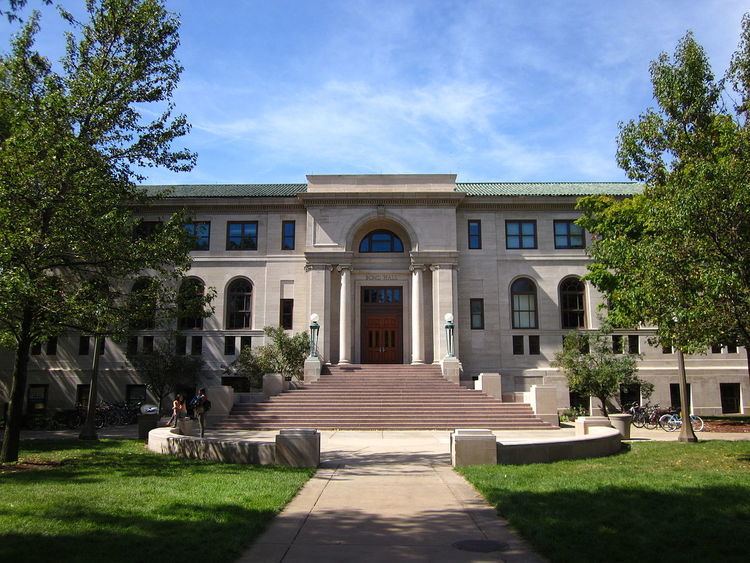Former names Lemonnier Library Opened 1917 | Type Academic Country United States Phone +1 574-631-6137 | |
 | ||
Status Used as the home of the school of architecture Similar Washington Hall, Stepan Center, Main Building, Sorin Hall, Morrissey Hall | ||
Bond Hall is a building on the campus of the University of Notre Dame which currently hosts the Notre Dame School of Architecture. It was originally built in 1917 as the Lemmonier Library. The architect was Edward Lippincott Tilton, a neoclassical architect who specialized in libraries. Its front steps are famous as the location of the Notre Dame Marching Band performances before the football games.
Contents
Lemmonier Library (1917-1964)
The current Bond Hall was built as Lemmonier Library in 1917 for $200,000 to replace the University's first library which was hosted on the third four in the east wing of the Main Building. The location of the new library, in the middle of the University farms, was also intended to make it less vulnerable to fire. Architect Edward Tilton of New York designed the two-story, Beaux Arts Classical structure, which was made from Indiana limestone. Rev. Thomas J. Shahan, D.D. blessed and dedicated the new library building on Sunday the 10th of June 1917, during the University's Diamond Jubilee celebrations. The building was named for Rev. Auguste Lemonnier, C.S.C. (1839-1874), the fourth president of Notre Dame from 1872 to 1874. Fr Lemonnier was the creator of Notre Dame’s first central circulating library in 1873. The great fire of 1879 destroyed all but 500 of the library’s 10,000 books. Following that disaster, the library’s collection grew to about 100,000 volumes when the move to the new Lemonnier Library was completed in 1917.
Architecture Building (1964-1995)
It served as library until 18 September 1963, when the Memorial Library (now Hesburgh Library was finished and all the books were transferred into it.
The old now vacant Lemmonier Library was give to the department of Architecture. The then head of the Architecture school, Frank Montana, designed plans to renovate the interiors to fit the new needs of the Architecture school. The original limestone exterior with Ionic detailing on the east side was preserved and restored. A 10,000 s.f. addition was also added to the west elevation. The interior was reconfigured to serve its new functions as architecture building and to correspond with its original classical character. The main challenge during the renovation was the removal of the library stacks, which had a structural function in the building. The main lobby became an exhibit hall, flanked on the north by the Architecture Library and on the south by a new lecture hall. The basement contained a darkroom and classrooms, and the mezzanine and second floor were converted into classroom space.The renovation itself was a learning experience for the architectural students themselves. Upon competition of the renovation, the new Architecture Hall hosted its first classes on 9 November 1964, while finishing touches were still being added. The formal dedication occurred on 1 May 1965, presided by Rev. Theodore Hesburgh, the University president, and Pietro Belluschi, dean of the School of Architecture at the Massachusetts Institute of Technology.
In 1973 it was added to the National Register of Historic Places
Bond Hall (1995-present)
A further renovation occurred in 1995, during which the building was closed for 18 months. The $12 million renovation was made possible by a $5 million gift from William W. Bond, Jr. ('50) and his wife Joanne. The Architecture department moved temporarily to the Hayes-Healy Center and Hurley Hall, which had been vacated by the School of Business for its move to the newly constructed business building on DeBartolo Quad. The renovation also included an American Renaissance style 20,000 square-foot addition on the west side designed by Ellerbe Becket under the guidance of architecture chairman Thomas Gordon Smith.
The building was rededicated as Bond Hall of Architecture on Friday, 21 March 1997, presided by Rev. Edward Malloy and the speakers included internationally renowned architects Allan Greenberg, Elizabeth Plater-Zyberk, and Demetri Porphyrios, who received honorary degrees from the school of architecture.
Architecture
The building is built in Indiana limestone, three stories high with an intermediate mezzanine level, low pitched green tile roof. A very careful Renaissance building that marks an early response to the Renaissance revival of the early twentieth century associated with "Ecole de Beaux Arts Classicism". A serious building with triumphal arch entrance and a grand flight of exterior stairs; the stairs are flanked by large lamps on copper tripods. Simple columns with Ionic capitols. The building is unified by a continuous cornice with a dentil course and egg and dart molding below that. Inside there is a large oval foyer and high skylighted room beyond, currently used as a display gallery. Marble has been used on the floors and some walls. Public spaces carry the classical motif throughout in moldings, panels, engaged columns and pilasters with appropriate capitols and bases. The west side of Bond Hall, opposite the main entrance, features a semi circular courtyard. On the facade, there is a sculpture of Vitruvius, over an inscription featuring a quote from his De architectura:
Architects who sought to be skilled with their hands without formal education have never been able to reach a position of authority in return for their labors; while those who relied only upon Reasoning and Scholarship were clearly pursuing the shadow, not the substance. But those who have a thorough knowledge of both, like men fully armed, have more quickly attained their goals with authority (Vitruvius, Ten Books on Architecture, I.II.II).
